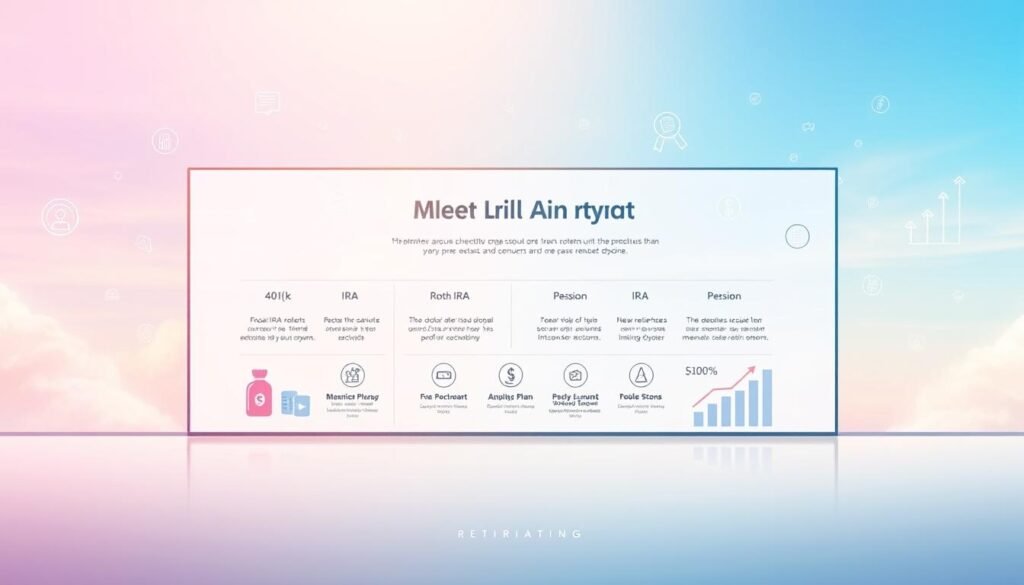
Best Retirement Plans USA Young Adults 2026: Top Picks for You

You might remember the first time you stashed a few dollars away and felt oddly proud. That small step often starts a chain where time and steady contributions turn little sums into real growth.
In this guide, you’ll find clear ways to match a plan to your job, whether you get an employer match or you’re self-employed and want more control. We’ll explain how employer accounts like 401(k)s and the Thrift Savings Plan can include matches, and how IRAs give flexible investment choices.
You’ll learn why Roth-style accounts can win early in your career, when taxes may be lower, and how traditional options cut taxable income now. For extra reading on new solutions and guaranteed-income ideas, see this retirement solution update.
By the end of this section you’ll have a simple map to pick a plan, set contributions, and protect momentum so your money works harder over time.
- Why starting now amplifies your long-term retirement growth
- Understanding retirement plan types at a glance
- Best retirement plans USA young adults: your 2026 buyer’s guide short list
- Employer-sponsored plans that offer higher contribution limits and matches
- 401(k): traditional vs. Roth, employer match, and 2025 contribution limits
- 403(b): for schools, hospitals, nonprofits, plus the 15-year catch-up rule
- 457(b): government and tax-exempt workers, special catch-up and no early penalty on separation
- Thrift Savings Plan: government’s low-fee option with Roth and traditional choices
- IRAs for young adults: Roth IRA vs. Traditional IRA benefits and trade-offs
- Self-employed and small business retirement accounts that boost savings
- Taxes, withdrawals, and RMDs: plan for distributions before you need them
- Your next steps to secure tax-smart retirement growth in 2026
Why starting now amplifies your long-term retirement growth
When you begin saving now, even modest monthly contributions can become meaningful later. Compound interest needs time to work, so regular contributions made early often produce outsized growth over the years.
Automate your savings with payroll deductions to make contributions effortless. You’ll build momentum, avoid decision fatigue, and capture employer matches that raise your effective return.

"Small, steady deposits plus time are the most powerful drivers of long-term wealth."
Starting early also lets you take bolder investment approaches. Volatility smooths out across decades, giving you a better chance at higher returns.
- Set a baseline contribution and increase it yearly by a small percent.
- Direct windfalls bonuses or tax refunds into savings to accelerate progress.
- Consider Roth IRA contributions when your income and tax bracket are lower to secure tax-free withdrawals later.
The benefit: You stack tax advantages, compounding, and disciplined habits. For practical steps and tools, visit study finance to get started today.
Understanding retirement plan types at a glance
Compare the main types of workplace and individual accounts to see which match your income and needs.
Defined-contribution options you’ll see at work
401(k), 403(b), 457(b), and the Thrift Savings Plan take payroll deferrals and may include employer contributions. Investment risk is on you, so pick funds that fit your time horizon and risk tolerance.
Defined-benefit choices that promise income
Pensions and cash balance designs calculate a payout using salary and years of service. Employers shoulder investment risk and guarantee an income stream, which can complement your other accounts.
Individual and self-employed accounts
IRAs including a traditional IRA and Roth IRAs let you open an account regardless of employer access. Limits are lower than workplace options, but you gain broader investment sources and full control.
If you are self-employed, consider Solo 401(k), SEP IRA, or SIMPLE IRA to boost savings. Check current Internal Revenue limits when deciding how much to contribute each year.

"Use plan type as your starting point: employer accounts for payroll ease, individual accounts for choice, and self-employed options for flexibility."
| Type | Who offers it | Risk | 2025 contribution limits |
|---|---|---|---|
| Defined-contribution (401(k)/403(b)/457/TSP) | Employers, government | Participant | $23,500; catch-up $7,500 (age 50+) |
| Defined-benefit (Pension / Cash balance) | Employers | Employer | Benefit based on salary & service |
| Individual (Traditional IRA / Roth / SEP / Solo 401(k)) | You / Self-employed | Participant | IRA $7,000 ( |
Best retirement plans USA young adults: your 2026 buyer’s guide short list
Your choice should hinge on employer type, eligibility rules, and whether you want tax savings now or tax-free growth later.

Quick picks by situation
- If your employer offers a match: Contribute at least enough to capture the full match in a 401(k) or similar account it’s immediate extra money for your savings.
- Schools, hospitals, nonprofits: A 403(b) may fit, and long service can unlock a 15-year catch-up to raise contribution limits.
- Government or tax-exempt work: Consider a 457(b) for special catch-up options and no 10% early withdrawal penalty on separation.
- Federal employees or military: The TSP gives low fees and up to a 5% match useful for steady contributions.
- No workplace account: A roth ira gives tax-free growth if your taxable income meets eligibility rules.
- Self-employed: Solo 401(k), SEP, or SIMPLE options let you boost contributions and choose Roth or traditional tax treatment.
Decision filters to narrow your options
Focus on four quick filters: eligibility, contribution limits, taxes now vs. later, and investment choice.
- Eligibility: Check employer rules and income limits for IRA access.
- Contribution limits: Workplace accounts allow much higher deferrals than IRAs; use limits to compare real saving power.
- Tax: If your current tax bracket is low, Roth contributions may win; if you need to lower taxable income now, consider traditional pre-tax deferrals.
- Investment choice: IRAs often offer broader fund menus; employer accounts may have cheaper institutional funds.
"Grab the match, mind contribution limits, and choose tax treatment that fits your income trajectory."
Employer-sponsored plans that offer higher contribution limits and matches
Workplace accounts give you access to larger annual limits and often include an employer match that raises your effective return. Use these options first to capture free money and hit higher contribution limits when you can.
401(k): traditional vs. Roth, employer match, and 2025 contribution limits
401(k) options typically let you choose traditional or Roth treatment so you can favor tax savings now or tax-free withdrawals later. For 2025, employee deferrals top out at $23,500. If you’re 50 or older, a $7,500 catch-up applies; ages 60–63 may reach $34,750 in certain cases.
Always contribute enough to capture any employer match; it’s instant value tied to your compensation.
403(b): for schools, hospitals, nonprofits, plus the 15-year catch-up rule
403(b) plans serve educators, hospital workers, and nonprofit staff. They share core limits with 401(k)s but may offer a special 15-year service catch-up.
Eligible long-tenured employees can add $3,000 a year for up to five years (lifetime max $15,000), increasing how much you can save during peak earning years.
457(b): government and tax-exempt workers, special catch-up and no early penalty on separation
Many government and certain tax-exempt workers use 457(b) accounts. They follow similar limits but let eligible participants use a special pre-retirement catch-up in the three years before normal retirement.
Withdrawals after separation are not subject to the 10% early penalty, though ordinary tax still applies.
Thrift Savings Plan: government’s low-fee option with Roth and traditional choices
The Thrift Savings Plan is the federal government’s low-fee option. It offers Roth and traditional accounts, a concise fund menu, and up to a 5% match for FERS employees. Note many matches vest on a three-year schedule.
"Minimize fees and max out matched contributions; small differences in costs and matches add up across your working years."
IRAs for young adults: Roth IRA vs. Traditional IRA benefits and trade-offs
Picking between IRA types often comes down to whether you prefer tax savings now or tax-free income later. This choice influences your taxes, withdrawals, and how long your money compounds.
Why Roth IRAs often win early
Roth IRAs use after-tax dollars so qualified withdrawals are tax-free after age 59½ and the five-year rule. You can withdraw contributions (not earnings) without penalties, and there are no required minimum distributions for the original owner.
Traditional IRA trade-offs
Traditional IRAs may give you a tax deduction today if you meet the rules. Distributions in retirement are taxed as ordinary income and required minimum distributions apply based on age and IRS rules.
Contribution limits, timelines, and eligibility
For 2025 you can put in $7,000 if under 50, or $8,000 if 50 or older. You may contribute for 2025 up to the April 2026 tax filing deadline.
- Eligibility: Roth eligibility phases out with income (single filers roughly $150,000–$165,000 in 2025).
- Backdoor option: If you can’t contribute Roth IRA directly, consider a backdoor Roth via conversion.
- Check taxes: Traditional IRA deductibility depends on workplace coverage and taxable income.
"Fund the account that matches your current tax bracket and long-term goals."
Self-employed and small business retirement accounts that boost savings
Self-employment opens doors to accounts that let you push more money into long-term savings. Pick the structure that fits your team size, desired flexibility, and tax goals.
Solo 401(k): combine employee and employer roles
Solo 401(k) lets you take employee deferrals up to $23,500 in 2025 ($31,000 if 50+). On top of that, you can add employer profit-sharing contributions to reach very high contribution ceilings.
A spouse working in the business can also join, increasing household savings and long-term outcomes.
SEP IRA: simple employer-funded option
SEP IRA uses only employer contributions. You can contribute the lesser of 25% of compensation or $66,000 for 2025. It’s easy to set up and has minimal administration, but it offers no catch-up for older owners.
SIMPLE IRA: for small teams up to 100 employees
SIMPLE IRAs cap employee deferrals at $16,500 in 2025 with a $3,500 catch-up. Employers must contribute, so workers always receive some benefit even in lean years.
- Compare fees and rules: Solo 401(k)s may need more filing at high balances; SEP IRAs are minimal; SIMPLE IRAs limit rollovers early on.
- Watch limits: Review Internal Revenue updates each year to keep contributions aligned with your income and goals.
"Choose the account that matches your business size, desired flexibility, and how much you want to save each year."
Taxes, withdrawals, and RMDs: plan for distributions before you need them
Knowing when taxes apply and how withdrawals work can protect the value you’ve built.
Pretax vs. Roth contributions
Pretax contributions reduce your taxable income today, lowering current tax bills. Withdrawals from those accounts are taxed as ordinary income later.
Roth accounts don’t cut taxes now, but qualified withdrawals are tax-free if you meet the age and five-year rules.
Withdrawals: rules, penalties, and exceptions
Early withdrawals can trigger penalties and extra taxes. Some exceptions exist, and certain account types differ.
For example, 457(b) accounts let you take distributions after separation without the 10% early penalty before age 59½, though ordinary tax still applies.
Required minimum distributions and a simple contribution order
Most pretax accounts and traditional IRAs require required minimum distributions starting at age 73 (75 for those born in 1960 or later). Roth IRAs do not have RMDs for the original owner.
- Pick pretax to lower taxable income now; pick Roth to lock in tax-free withdrawals later.
- Secure any employer match first, then contribute Roth IRA if eligible, then return to max your workplace account.
- Review distributions rules yearly so taxes and penalties don’t erode your gains.
"Plan distributions now so tax rules don’t force costly moves later."
Your next steps to secure tax-smart retirement growth in 2026
Start with one clear checklist for 2026 set a contribution rate to capture any employer match, choose a target that fits your income, and schedule small increases as raises arrive this year. Use current limits (2025 values) as a guide but confirm IRS updates before final elections.
Open or fund the right retirement account often a Roth IRA if you can contribute. Review plan menus and favor low-cost index or target-date investment options that match your age and time horizon to keep more of your money working and support long-term growth.
Map distributions and withdrawals now so taxes and penalties don’t surprise you later. If you want help, contact a qualified advisor or tax professional, check provider service details and credible sources, then document your steps and set calendar reminders this year.
If you want to know other articles similar to Best Retirement Plans USA Young Adults 2026: Top Picks for You you can visit the category Investing.






Leave a Reply